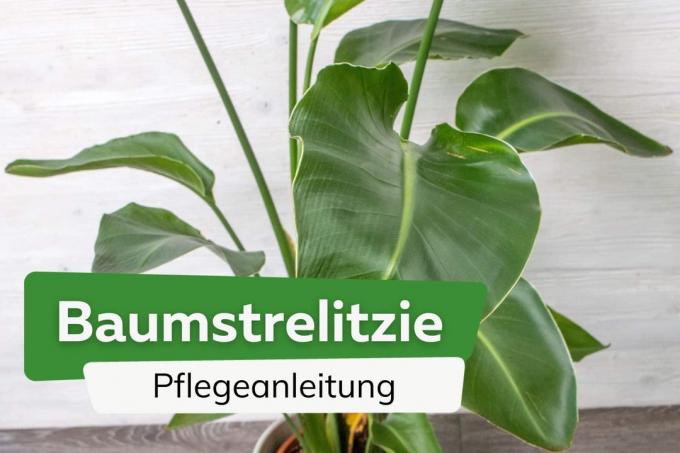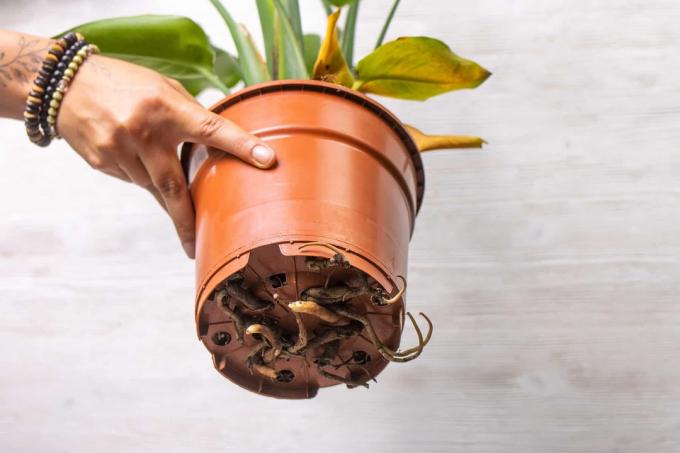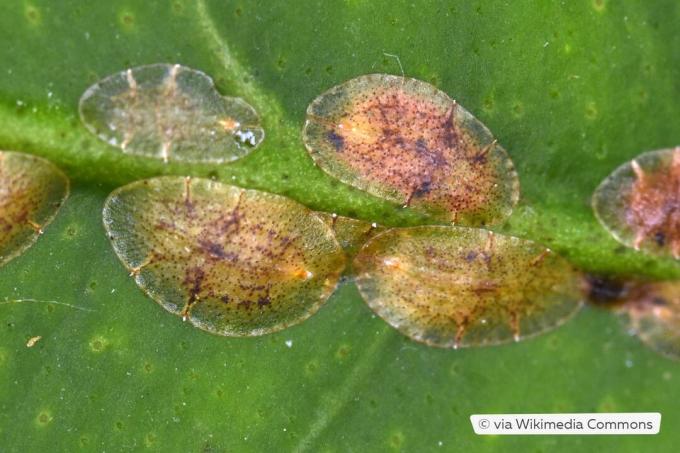
Profile and care information open +close -
- flower color
- orange, white, blue
- Location
- Partial shade, shady, sunny, full sun
- heyday
- April May June
- growth habit
- upright, sweeping
- Height
- 150 - 200cm
- soil type
- sandy, loamy
- soil moisture
- moderately moist
- PH value
- neutral, slightly acidic
- lime tolerance
- Lime tolerant
- humus
- rich in humus
- Poisonous
- Yes
- plant families
- Strelitzia family, Strelitziaceae
- plant species
- Indoor plants, potted plants, balcony plants, ornamental plants, perennials
- garden style
- Ornamental garden, perennial garden
The Tree Strelitzia (Strelitzia nicolai) is a fascinating tropical plant that provides an exotic flair. In order for it to thrive optimally, attention must be paid to a few details when caring for it.
Table of contents
- Location
- substrate
- Pour
- Fertilize
- Cut
- repot
- hibernate
- multiply
- division
- Side shoot without roots
- diseases/pests
- Root rot (Pythium)
- Spider mites (Tetranychidae)
- Scale insects (Coccoidea)
- frequently asked Questions
Location
Because the Tree Strelitzia comes from the tropics, it is important that the location offers similar conditions. Therefore, some aspects should be considered when choosing a location.

- bright to very bright, like full sunlight
- Ambient temperature between 18 and 27 degrees Celsius
- at least 60 percent humidity
- Sufficient space for unrestricted leaf spread
- no draft
- in summer a wind-protected open-air place
substrate
The substrate mainly determines how well or poorly a Strelitzia nicolai will thrive. In order to meet their supply requirements, the substrate should meet these criteria:
- High quality for less mold risk
- loose and permeable
- likes sandy and loamy
- nutrient-rich and moderately high humus content
Tip: If you mix coconut fibre, perlite or similar between the substrate, the degree of looseness increases, which prevents any compaction in the long term.
Pour
The tree strelitzia likes a consistently light soil moisture, which is why it should be watered regularly. It is essential to prevent waterlogging. The best time to water has come when the surface of the earth can be dented by a maximum of two centimeters without any effort. In addition, the moisture-loving exotic plant should be regularly treated with lime-free be sprayed with water.

Fertilize
The bird of paradise flower and parrot flower, as this Strelitzia is also called, has a relatively high nutrient requirement, which must be covered by fertilizing. The following guidelines should be adhered to:
- Apply green plant fertilizer every four weeks from April to October
- alternatively use nutrient-rich long-term universal fertilizer in April and July
- recommended: use liquid fertilizer with irrigation water

Cut
Tree Strelitzia do not need pruning. Withered flowers and dried, dead or torn leaves and withered stems can be cut off without any problems if this is desired for visual reasons.

repot
Until a bird of paradise has fully grown, it should be repotted every two to three years in early spring so that there is enough space for the roots. Once it has reached its height, the pot/bucket should have a diameter of around 40 centimetres. This allows the roots to crowd tightly together, which is conducive to flowering. Repotting is only rarely recommended for adult specimens because it negatively affects flowering.

When repotting, you should pay attention to the following details:
- knock on bucket walls to loosen substrate
- Carefully pull the plant out of the soil to avoid tearing or breaking the roots
- Remove old substrate from roots as far as possible
- use structurally stable substrate for mature plants
- only use thoroughly cleaned pots/tubs
- for "young" plants, choose a pot 5 to 10 cm larger
- Lay a drainage layer of expanded clay, quartz sand, grit or gravel that is at least 2 cm high on the ground
- Fill in the substrate so high that the upper root area is a few centimeters below the edge of the bucket
- Insert the plant and fill cavities with substrate
- Lightly press down the soil
- Water moderately and ensure continuous soil moisture

A notice: The Tree Strelitzia needs a long time and a minimum growth to grow for the first time to bloom. This can take between three and six years. From the first flower it is considered fully grown.
hibernate
The parrot flower cannot hibernate outdoors in the Central European winter because it is not frost-resistant. If she has spent the summer outdoors, she should be moved to a warmer location by mid-October at the latest.
It can spend the winter in a sunny place at normal room temperature. Regular spraying is particularly important here because of the dry heating air. Watering is done as usual and fertilizing can be reduced to every two months.
However, it is advisable to let them go into hibernation. This is conducive to their flowering.
This is how the hibernation works:
- Ambient temperature between 10 and 15 degrees Celsius, better between 12 and 14 degrees Celsius
- Stop fertilizing from October until next spring
- only water so much that the substrate does not dry out completely
- bright and shady to semi-shady location
multiply
The propagation of the bird of paradise flower can be done by two different methods. Often the propagation should not be carried out, as this can lead to a disturbance in the formation of flowers.
division
The easiest and most promising way of dividing is to repot by dividing the roots. The ideal time is between March and April.
That's how it's done:
- remove soil from planted root area
- Look for side shoots with roots and at least three leaves and separate them from the mother plant with a sharp knife
- alternatively: Cut through the root area in the middle
- Plant root parts in nutrient-rich, loose substrate and water vigorously
- Don't forget drainage
- fertilize at the earliest six weeks after division/planting
Side shoot without roots
Another option is to cut off a side shoot without a root. This method is a bit more involved, but works well.
That's how it's done:
- Cut off healthy, strong, young side shoots with at least three leaves directly at the base
- should not have a flower
- place in a vase with lime-free water for root formation in a sunny, warm location (leaves must not be in the water)
- change water every other day
- first roots visible after about seven to ten days
- When three roots have formed, plant in a pot with nutrient-rich substrate and water
- carry out the usual maintenance measures
A notice: All parts of the Strelitzia nicolai plant are slightly poisonous if consumed. This can lead to symptoms of poisoning such as nausea, vomiting and diarrhea, which is why the exotic plant should not be displayed within the reach of children and pets.
diseases/pests
The tree strelitzia is generally considered to be a robust and hardy plant. However, diseases and pest infestations are possible, which are usually due to incorrect care.
Root rot (Pythium)
If the Tree Strelitzia is watered too much or waterlogging occurs, root rot will develop quickly. This is noticeable by a musty smell that rises from the substrate. In addition, the plant loses stability, leaves turn yellow, it slowly dries up and dies.
If the following actions are taken early on, the parrot flower can be saved:
- Unpot the plant and remove the substrate from the roots as much as possible
- heavily softened and possibly Cut off the mushroom-covered parts of the root
- let air dry for a few hours
- Thoroughly clean and disinfect the pot/bucket
- replant the plant
- do not water, but slowly start watering after three days
- Optimize watering behavior to prevent renewed root rot
Spider mites (Tetranychidae)
If the Strelitzia nicolai appears weak and whitish-yellow spots appear on the leaves, a spider mite infestation present. These pests suck the sap from the foliage. They are particularly common when the air is dry. On closer inspection, about 0.25 to 0.8 millimeters, pale green to yellow-green, orange to reddish-brown, elongated-bodied creatures can be discovered. They settle mainly on the undersides of the leaves and form white, sticky webs. You can reliably get rid of them with a spray treatment.

That is how it goes:
- Put 20 grams of curd or soft soap in 1 liter of boiling water and dissolve in it
- Add 30 milliliters of alcohol
- fill into spray container after cooling down
- In case of severe infestation, spray the plant, especially the leaves, several times a day until dripping wet, otherwise once a day for around 1 week
Scale insects (Coccoidea)
Also scale insects dry humidity drives the Strelitzia nicolai more. They are up to six millimeters in size, brown, yellowish, black or reddish, spread a sticky, clear honeydew on the leaves and deprive the exotic plant of vital nutrients. Smallpox-like formations on the undersides of the leaves and shiny leaves indicate an infestation.

This can be remedied in this way:
- If there is a small scale infestation, simply wipe it off with a cloth and dispose of it
- In the case of a larger infestation, spray the plant with neem, paraffin or rapeseed oil
- use an alternative spray solution with a tablespoon of soft or curd soap in a liter of water
- Spray the plant several times a day until no more pests are visible
frequently asked Questions
This is not advisable. The Streilitzia nicolai is not hardy and would have to be dug up again every autumn for frost-free wintering. The risk of damaging roots is too great. In addition, it does not tolerate frequent transplanting. But some hobby gardeners put a tree Strelitzia in a bucket in the garden bed. It can be removed together with the pot, so that no root damage is to be expected and the exotic plant is spared the strain.
Because the chance of germination of the seed is very small and therefore not worth the effort. The seed coat is relatively thick and firm, so that germination without "help" is hardly or not at all possible. Sanding is then helpful, but this increases the risk of seed rot immensely. The easiest way is therefore the division or the propagation of cuttings from side shoots.
Most of the time there is a maintenance error. Check your previous care measures against those mentioned in the guide. It can be due to too much water or too dry soil, but also to drafts. If it is too dark, this particularly inhibits flowering. Or maybe you repot your Tree Strelitzia too often. Follow the tree strelitzia care guide if your specimen is to bloom soon.



